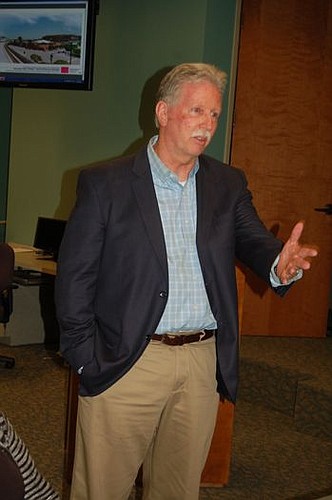
For the first time in more than seven years, Tim Miller sat in the back of the room and was a spectator during the Downtown Development Review Board meeting.
Miller, principal architect at Ervin Lovett Miller, was the board’s chairman for the past two years and was invited Thursday to be recognized at the first meeting since his appointment expired.
The board approves all exterior design and site plan aspects of new Downtown construction and renovation.
During his term, Miller and his colleagues including architects, landscape architects, engineers, construction executives and Downtown business owners reviewed dozens of projects, many of which have become part of the urban core’s streetscape.
His time on the board was during an interesting period in real estate development and he had the opportunity to “watch the economic pendulum swing,” he said.
By the time he marked his first anniversary on the board, the real estate bubble had burst and the recession had begun.
“In 2007, things were still hot and heavy. We saw a lot of big projects, but they never got off the ground,” said Miller.
Over the next four years, the board mostly reviewed new signs that businesses wanted to install on their buildings. Few major projects were reviewed and even fewer became reality.
Toward the end of Miller’s term, the pendulum began swinging back to more development opportunity.
“In the past year or two, we started to see big projects again. We went from good to bad and back to good,” he said.
Among those that stand out are three projects along Riverside Avenue that created a new neighborhood at the gateway to Downtown: 220 Riverside and Unity Plaza; the Brooklyn Station that includes Fresh Market; and Brooklyn Riverside. The project combined two apartment properties with a shopping center and a public event space.
“All three of those projects required a lot of compromise,” said Miller. “There was a lot of give and take to get those projects approved.”
In addition to the usual review and approval process, the board scheduled several design workshops with the developers and designers to come up with plans that made the projects economically viable while following Downtown design standards.
“That project was a great example of what can happen when people who look at projects from completely different viewpoints work together,” Miller said. “I think that project could prove to be a catalyst for residential development in all areas of Jacksonville.”
On a more personal note, Miller said another project he feels defined his term on the board is the Laura Street Trio and Barnett Building redevelopment. His firm worked on the original concept for the adaptive re-use of the four historic buildings along Laura Street.
“We created an idea that was workable,” he said. “There’s a new architect on the project now, but many of the concepts in our original design are included in the new plans.”
Miller said during his terms as chairman, the work of Office of Economic Development Redevelopment Coordinator Jim Klement, who advises the board on Downtown-specific regulatory issues, and city Assistant General Counsel Jason Teal, who provides legal opinions related to board action, made the board more effective.
“In the two years I was chair, the staff did a great job. They kept us out of the weeds,” Miller said.
@DRMaxDowntown
(904) 356-2466